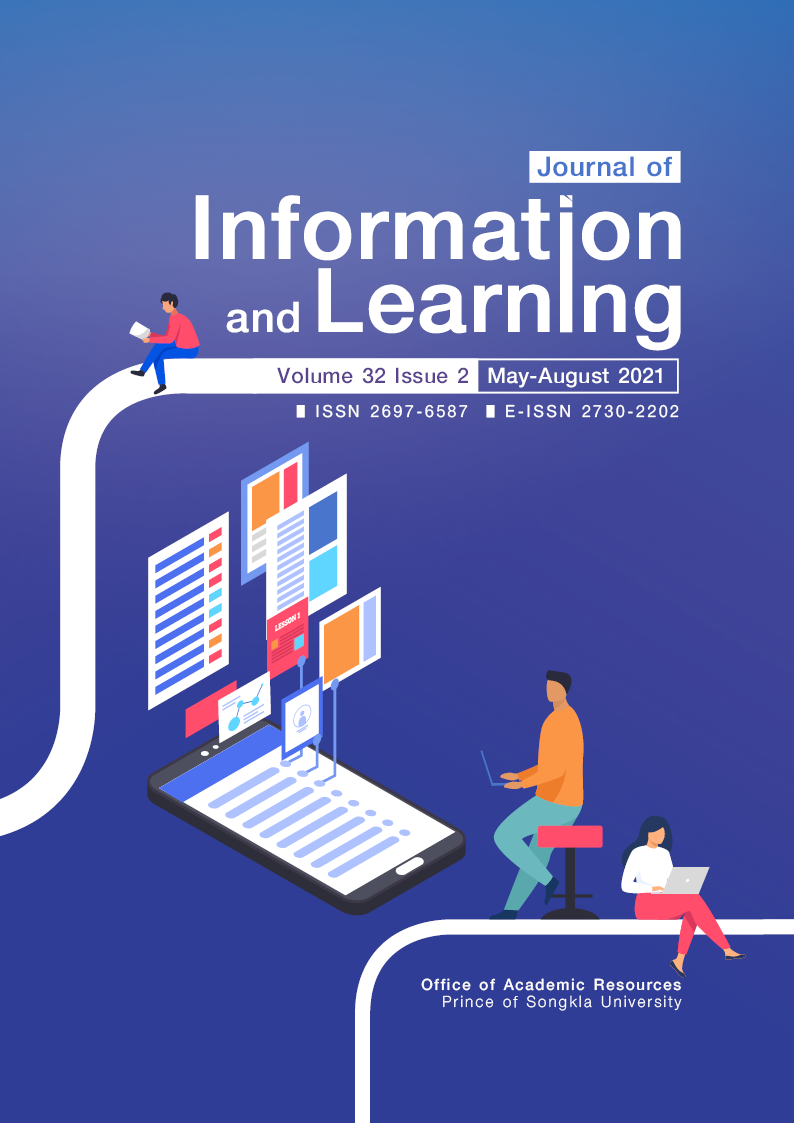การเรียนรู้ข้ามวัฒนธรรมผ่านศิลปวัฒนธรรมของเยาวชนมุสลิมในสามจังหวัดชายแดนภาคใต้
Main Article Content
บทคัดย่อ
วิจัยนี้มีวัตถุประสงค์เพื่อศึกษาการเรียนรู้ข้ามวัฒนธรรมผ่านศิลปวัฒนธรรมของเยาวชนมุสลิมในสามจังหวัดชายแดนภาคใต้ โดยใช้ระเบียบวิธีวิจัยเชิงคุณภาพ ผู้วิจัยเก็บข้อมูลจากเอกสารและภาคสนาม โดยเลือกผู้ให้ข้อมูลหลักเป็นกลุ่มเยาวชนมุสลิมในศูนย์การศึกษานอกโรงเรียน และการศึกษาตามอัธยาศัยในอำเภอเมืองปัตตานี จังหวัดปัตตานี อำเภอสุไหงโก-ลก จังหวัดนราธิวาส และอำเภอเบตง จังหวัดยะลา ด้วยวิธีการสังเกต การสัมภาษณ์เชิงลึกเยาวชนมุสลิม 40 คน เยาวชนชาวพุทธ 6 คน ซึ่งมีอายุระหว่าง 15-25 ปี นักวิชาการ 7 คน ผู้ปกครองเยาวชนมุสลิม 8 คน จากนั้นนำข้อมูลมาตรวจสอบสามเส้าด้านข้อมูล วิเคราะห์ความถูกต้องตรงประเด็น และรายงานผลเชิงวิเคราะห์พรรณนา
ผลการศึกษาพบว่า เยาวชนมุสลิมส่วนใหญ่มีประสบการณ์เรียนรู้ด้านศิลปวัฒนธรรมไทย จีน และตะวันตก โดยเฉพาะไทยและจีนมีประสบการณ์ทางตรงมากที่สุด เนื่องจากมีชาวไทยพุทธและเชื้อสายจีนอาศัยอยู่ร่วมกันกับชาวมุสลิม ศิลปวัฒนธรรมไทยเรียนรู้ผ่านหัตถศิลป์ การแสดง การแต่งกาย สถาปัตกรรมวัดไทย เทศกาลประเพณีไทย ศิลปวัฒนธรรมจีนเรียนรู้ผ่านการแสดง สถาปัตยกรรมศาลเจ้าจีน เทศกาลประเพณีจีนที่จัดขึ้นประจำปี ศิลปวัฒนธรรมตะวันตกมีประสบการณ์ทางอ้อม ชาวตะวันตกไม่ปรากฏนักแต่สามารถเรียนรู้ศิลปะต่างๆ ผ่านสื่อ เยาวชนมุสลิมส่วนใหญ่เรียนรู้ข้ามวัฒนธรรมเพื่อสังคมมากกว่านำมาปรับพฤติกรรม ยกเว้นสิ่งใดที่ไม่ขัดหลักศาสนาอิสลามก็จะนำมาปรับใช้ภายใต้คำชี้นำของผู้นำศาสนา การเรียนรู้ไม่ว่าด้านใดมีวิธีการไม่แตกต่างกัน เยาวชนใช้วิธีการฟัง การดูภาพ และการอ่านข้อความจากโทรทัศน์ คอมพิวเตอร์ และโทรศัพท์มือถือ การอ่านและดูภาพจากสิ่งพิมพ์ การฟังผู้รู้และดูศิลปะจากสถานที่จริง โทรศัพท์มือถือได้รับความนิยมมากที่สุด การเรียนรู้ข้ามวัฒนธรรมบรรลุผลได้มาก เมื่อใช้สื่อและวิธีที่หลากหลาย โดยเฉพาะการเรียนรู้จากสถานที่จริง
Article Details

อนุญาตภายใต้เงื่อนไข Creative Commons Attribution-NonCommercial-NoDerivatives 4.0 International License.
Journal of Information and Learning ดำเนินการโดยสำนักวิทยบริการ มหาวิทยาลัยสงขลานครินทร์ วิทยาเขตปัตตานี บทความที่ได้รับการตีพิมพ์ในวารสารได้รับความคุ้มครองตามกฎหมายลิขสิทธิ์ โดยเจ้าของลิขสิทธิ์จะมีสิทธิในการทำซ้ำ ดัดแปลง และเผยแพร่งานบทความ ทั้งรูปแบบอิเล็กทรอนิกส์ การทำฉบับสำเนา การแปล และการผลิตซ้ำในรูปแบบต่างๆ ลิขสิทธิ์บทความเป็นของผู้เขียนและสำนักวิทยบริการ มหาวิทยาลัยสงขลานครินทร์ วิทยาเขตปัตตานี วารสารฯ ขอสงวนสิทธิ์ในการพิจารณาตีพิมพ์ตามความเหมาะสม รวมทั้งการตรวจทานแก้ไข การปรับข้อความ หรือขัดเกลาภาษาให้ถูกต้องตามเกณฑ์ที่กำหนด สำหรับผลการวิจัยและความคิดเห็นที่ปรากฏในบทความถือเป็นความคิดเห็นและอยู่ในความรับผิดชอบของผู้เขียน
เอกสารอ้างอิง
Badrul, I. (2009, June 13) Multiculturalism in art education: A malaysia perspective. Retrieved from http://www.unesco.org/culture/en/ file/29700/11376859351isa_
Banyen, U. (2017, September 30) Kānchai theknōlōyī dičhithan (Digital Technology ) phư̄ a lot khwām lư̄ amon thāngkān sưksā khō̜ng yaowachon nai sām čhangwat chāidǣn phāk tai [Using digital technology to reduce disparities in education of youth in the three southern border provinces] Retrieved from http://www.awc.ac.th/awcdata/research/15.pdf
Blum, L (1998). Antiracism, multiculturalism, and interracial community: Three educational values for a multicultural society. In applied ethnics : A multicultural approach (pp 14– 30) (2nd ed.) New York: Prentice Hall.
Chaiyarab, P. (1991). Khwām mai sō̜tkhlō̜ng rawāng kitčhakam kān rīan kānsō̜n nai rōngrīan prathom sưksā kap phrưttikam thāng watthanatham khō̜ng nakrīan thī napthư̄ sātsanā ʻItsalām nai sām čhangwat chāidǣn phāk tai [A study of the level of irrelevancies between instructional activities in elementary schools and cultural behavior of students with islamic belief in the three southern border provinces] (Master’s thesis), Chulalongkorn University, Bangkok.
Chapakiya, I. (2006, March 25) Kānčhatkān sưksā radap ʻudomsưksā tām thatsana ʻItsalām [Higher education management from the Islamic perspectives]. Retrieved from https://www.gotoknow. org/posts/26165
Earley, P., & Ang, S. (2003, January 23) Cultural intelligence: Individual interactions across cultures. Retrieved from https://www.research gate.net/publication/40421838_
Harnish, D. (2011). Tension between adat (custom) and agama (religion) in the music of Lombok. In Hardish, D & Rasmussen, A. (Ed.), Divine inspirations: Music and Islam in Indonesia (pp. 80-108). London: Oxford University Press.
Jansson, H., Johanson, M., & Ramström, J. (2007, October 15) Institutions and business networks: A comparative analysis of the Chinese, Russian, and West European markets. Retrieved from https://www.researchgate.net/publication/2225382 86_Institutions_and_business_
Kaeophimon, P., Sisuk, W., & Nayai, U. (2018). Lessons learned of religious leaders for the development of southern societies: A field trip study in multicultural societies. Princess of Naradhiwas University Journal of Humanities and Social Sciences, 5(1), pp 71-82.
Langputeh, S. (2009, May 3). Suk phāwa thāng panyāsa rāng suk khon tai sangkhom phahu watthanatham: phalang thāng sangkhom sū kānphatthanā suk phāwa khō̜ng khon tai [Intellectual well-being creates happiness of Southern people, Multicultural Society: Social synergy to the well-being development of southern people]. Retrieved from https://www.happynetwork.org/upload/forum/doc49 b49dbe44
Praphrutchop, P. (2017, July 22). Kānchai chīwit khō̜ng yaowachon nai sangkhom phahu watthanatham kō̜ranī sưksā : phonkān čhat kitčhakam kān lǣkplīan rīanrū phư̄ a phatthanā thaksa chīwit dektāng watthanatham nai phư̄ nthī phāk tawanʻō̜k chīang nư̄ a [Life of youth in multiculture society: Results of learning exchange activities to develop children skills for different cultures in the northeastern region]. Retrieve from https://www.skthai.org/private_ folder/download/IDIL_
Sathamalinee, S. (2014, May 15). Kānsāng santiphāp læ santiwithī nai withī ʻItsalām [Peace Building and Peaceful way in the Islamic Way]. Retrieved from https://deepsouthwatch.org/node/5702
Sirisakdamkoeng, P. (2006). Nǣokhit phahu watthanatham [Multicultural concept]. Bangkok: National Research Council of Thailand.
Tantrawanich, K. (2017, May 25). Nayōbāi dān khwāmmankhong phư̄ a kān khumkan yaowachon čhāk krabūankān thī tō̜sū dūai withī chai khwāmrunrǣng [Stability policies to guard youth from combative processes with violence means]. Retrieved from http://www.dsdw2016.dsdw.go.th/doc_pr/ndc_2559-2560/PDF/wpa_
Tepsing, P. (2012). Process of arts learning in social and cultural context of Southern Thai Border: Case study of public educational institutions. Institute of Culture and Arts Journal, 14(1), 85-94.
Tomalin, B., & Stempleski, S. (2006). Cultural awareness. Bangkok: Window on Education
Upper Secondary Education Bureau. (2016, October 12). nǣo kānčhatkān rīanrū nai satawat thī yīsipʻet [Guideline to learning management in the 21st Century]. Retrieved from https://webs.rmutl.ac.th/assets/ upload/files/2016/09/20160908101755_
Yongyuan, B., & Padungphong, C. (2009). Kānchai kitčhakam sinlapa phư̄ a songsoē m kānyō̜mrap khwāmlāklāi thāng watthanatham nai sangkhom phahu watthanatham [Using art activities to encourage the acceptance of cultural diversity in a multicultural society]. In Niran, S (Ed.), Long Lae research in PSU (p 154). Songkla: Prince of Songkla University.


